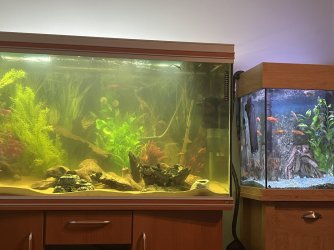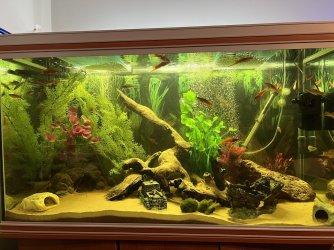A lot of people recommend play sand for substrate. It can be an alternative to expensive specially processed sand. I have used it. But there is no specification of what play sand really consists of, additionally it is a heavy item and companies that produce aggregates ship as little as possible, which means your sand is likely different than the persons who recommended the sand, even if you used the same company.
Further the play sand is treated in different ways before being packaged and shipped. Most is somewhat screened selected runs but the biggest concern the manufacturer has is ensuring no contamination is found in the sand, but that doesn't mean it can be made with a lot of clay silt and mud in it. Which to an extent play sand needs at least some of these fines to give it the characteristics that make play sand appropriate to play with.
Overall, what I am saying is that play sand is a highly variable product which will have a varying degree of fines in it. Additionally there is no control over the shape of the sand particles. The last time I used play sand I rinsed batches of it in wheel barrow first before doing bucket amounts of rinsing. During this process I found chunks of mud and clay in the sand, and I lost 20 to 25% of the initial volume of sand during the cleaning.
My rant over, I found that once the sand was in the tank you can remove the fines by carefully vacuuming the surface of the sand after the tank has settled a bit (reduce the currents for a day or so before the vacuuming). Then use a polishing filter to remove what ever is left. You might have to do this multiple times. Additionally the real fine stuff can be difficult to remove, the easiest way to do this, is to ignore it. Each particle floating in the water is a point where algae and other microorganisms will collect and eventually the filter will take them out. In a couple of cases I have had strong algae blooms associated with sand, and these speed up the removal of the fines. Eventually you will find the tank clearing up of its own accord unless the entire depth of the sand is being disturbed. An alternative might be to add a flocculant, clearing agent, to the tank then filter heavily. I haven't done this with a tropical tank so I cannot fully recommend this method personally.
Substrates I have used and the relative amount of fines and other particles not desired in the substrate:
Play Sand - Worse of any I have used (used for 3 tanks)
Black Florite Sand - For a commercial product this has a massive amount of fines, also the particles are slightly magnetic making them hard with the typical impeller driven filters (used 4 times, works good with air driven sponge filters)
Personally collected gravel - What I used to do always many uses, generally pretty dirty to start, but easy to clean.
Personally collected sand - Usually cleaner than the gravel because I has smaller pore spaces (I believe) but still pretty dirty.
Chicken grit - Dirty but easy to clean, not appropriate for most tanks. Too sharp
Commercial Fish Sand (Natural) - Only done this a couple of times but the sand was pretty clean.
Commerical Fish Gravel (Natural) - Only done this a couple of times but the gravel was pretty clean.
Sand Blasting Silica (20 mesh) - Very clean semi rounded particles, I found it too light both in appearance and ease of stirring up might work better if mixed with 30 mesh. In the end I used this without rinsing. Twice as expensive as play sand but I believe it to be a better choice.
Crushed Glass (20 mesh) - An experiment, particles very light, product very clean, did not like the looks and worried about the fish and my hands. Did not affect my hands, plants and fish did ok with it but would not use it for bottom dwellers.
None of these are perfect, but each has its niche. I would wait for your tank to clear, it will eventually, and next time spend more time rinsing your substrate. Not do not rinse Aquarium Soils, you will destroy them.
 . I’m concerned that my tank never looks clear, and also that I’m going to blow my filter… any tips?
. I’m concerned that my tank never looks clear, and also that I’m going to blow my filter… any tips?


